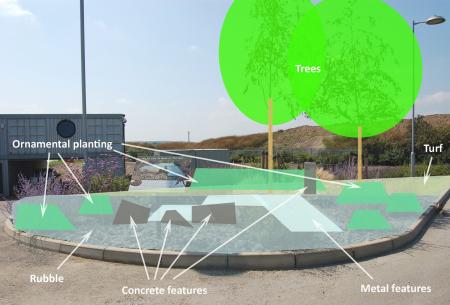
Resource description:
Innovative landscape design recommendations for maximising the biodiversity value of multi-functional urban green infrastructure (UGI) - designing with regional context
Author/Contact:
Stuart Connop, TURAS Expert - stuart@uel.ac.uk
Requirements:
- Consideration of multifunctional ecosystem service provision needs to be included into the design of Urban Green Infrastructure rather than knee-jerk reactions focused on single or narrow ecosystem service provision.
- Central to this, should be the aim of maximising the habitat and habitat connectivity value of UGI in order to maximise the biodiversity supported by urban green space and thus, in turn, maximise the ecosystem services supported by biodiversity.
Advantages:
- Ecomimicry of regionally important habitats in Urban Green Infrastructure design represents a mechanism for supporting a broader diversity of habitats and species in urban areas and thus providing opportunities for reconnecting urban communities with natu
- An example of this includes brownfield (post-industrial) sites that arise within the urban landscape. The mosaic of low nutrient habitats found on brownfield sites can have exceptionally high biodiversity value and can represent regionally important habit
- Main outcome: physical improvements and community empowerment.
Constraints:
- Nature deficit is a common problem in high-density urban areas where urban design has marginalised biodiversity to a few common species. Urban Green Infrastructure (UGI) represents a mechanism for restoring high-quality green space to urban areas to provi
- Design of Urban Green Infrastructure for single/narrow ecosystem service provision (e.g. stormwater management) and roll out of industrially standardised systems mean that opportunities to foster conservation or restoration of biodiversity are often misse
Uses of this resource:
Urbanisation, understood as the ongoing concentration of human activities in dense agglomerations, has far-reaching global environmental repercussions beyond the highly publicised hike in GHG emissions triggered by increased economic activity. High levels of urban density, industrial activity, and mobility also have local consequences in terms of reducing green and open spaces and associated effects such as loss of habitats. With substantial areas of the rural environment undergoing agricultural intensification leading to additional habitat loss, fragmentation and the widespread use of herbicides and pesticides, urban areas have an increasingly important role in supporting biodiversity. Urban Green Infrastructure implementation represents a mechanism for enhancing this role of urban areas. Increasingly, biodiversity is being linked to increased resilience of ecosystems and broader ecosystem service provision. Unfortunately, however, a combination of single financial drivers (e.g. stormwater management), lack of understanding in terms of ecosystem function, and aesthetics tend to be driving Urban Green Infrastructure implementation. This can lead to missed opportunities in terms of biodiversity benefits and multifunctionality.
This tool focuses on social sustainability and ecological sustainability.
Additional information:
Who should be involved?
- Facilitatory (public) bodies
- Green spaces department
- Community development department
- Planning & development department
- Land use department
- Environmental & sustainability department
- Local task force
- Local or regional authority
- Researcher
- Professional expert
- Community group
Suitable for:
- Brownfield development site
- Underused urbam site & building
- Dense inner city
- Urban region
Main necessary resources are:
- Space
- Monetary investments
- Expert knowledge
- Local knowledge
- Personnel time
- Institutional set-up
Licence:
- Free, no licence
Development stage:
- Full, working product
Quality assurance:
- Own QA and testing